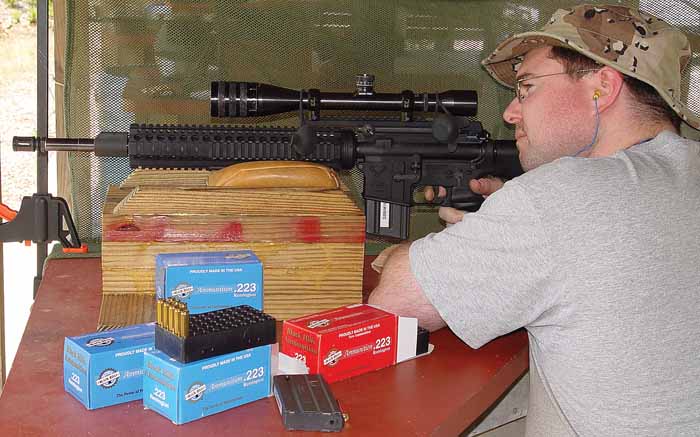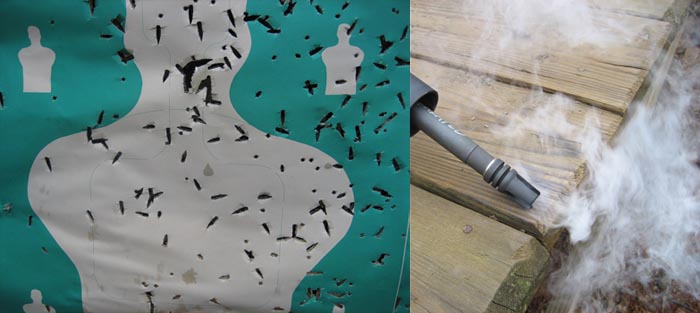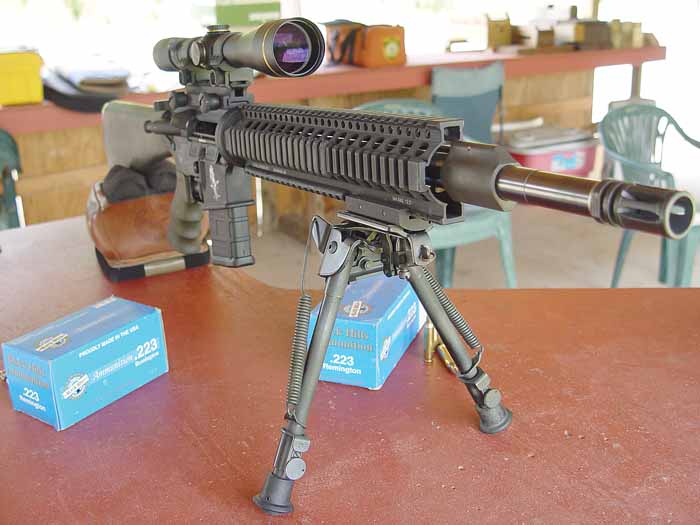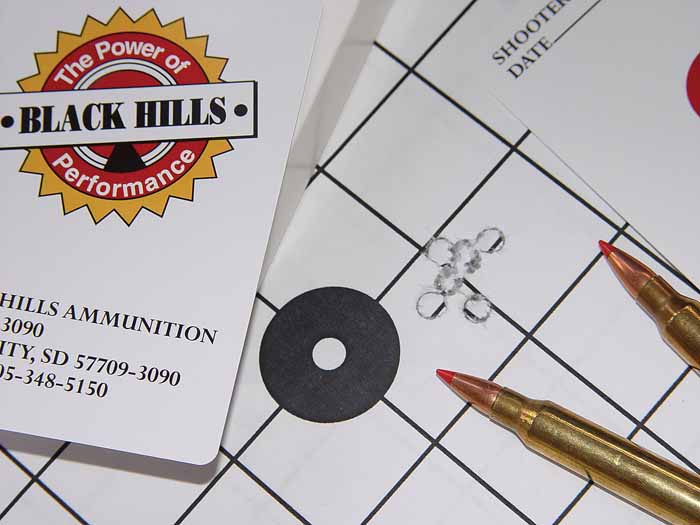By Steve Baughman
Since the beginnings of the creation of firearms, man has had a continuing quest to develop guns that shoot faster, farther, and with more accuracy. Technology and manufacturing process imrpovements in the art of rifle building continue, and the benefits are applicable to all of us in the shooting community. Much of these improvements start with the rifle barrel itself.
Superior Barrels, a small up-start company, was created with the purpose of building barrels that shoot with outstanding accuracy longer than has generally been achieved. Undoubtedly, most barrel manufacturing companies already provide outstanding quality and accuracy in their products, and that is good enough for most of us. Superior Barrels goal is to provide a barrel that holds that accuracy for many more rounds, and perhaps up to three or four times longer than other barrels manufactured today. Their process called Hard Blue brings that innovative difference to the industry.

John Hearn, the president of Superior Barrels, was previously a former rocket-scientist type who worked for a major defense contractor and the victim of company downsizing and career changing in mid-life. Being forced into this transition, he chose the honorable path as that of a firefighter. After the events of 9/11, he started focusing his attentions towards gun barrel designs. With his background expertise in aerospace structures and advanced materials, his company is using similar metallurgical processes to improve a gun barrel’s ability to withstand the degrading effects of high temperatures and throat erosion that result from prolonged rapid firing.
Despite what the evening news reports, and the ever-tightening economic situation the country faces, one thing that remains constant and sometimes “under the radar” is that the aircraft and space industry continue to push the technological envelope in the development of specialized materials and advanced structures. Without these materials advances, the performance of our modern military hardware would not be where it is today. Metallurgy science is generally a boring subject for the best of us; however if there is a better mousetrap out there, the spin-offs from military research and development are of obvious interest to the small arms industry.

Mr. Hearn’s previous career in the rocket world focused on refining high temperature materials, and being a shooter, he knew there was potential for utilizing similar technologies in gun barrels. His initial investments and experimentations culminated during 2004, when the company started producing AR-15/M16 variant barrels that last an exceptionally long number of rounds, without the typical degradations in accuracy experienced over time. They currently estimate that their AR barrels will provide up to three or possibly four times the barrel life of what has become the accepted standard, perhaps providing acceptable accuracy up to 20,000 rounds.

During initial meetings with the company, they displayed one of their AR-15 rifles that had 2,000 documented rounds fired with essentially zero throat erosion, and another one with 4,000 rounds with 0.01 inches (0.254 mm) of throat erosion. Most heavy-triggered machine gun enthusiasts know first hand the effects that high temperatures have on barrel degradation and resulting accuracy loss, so the obvious benefits that their process could add to the shooting industry are substantial. One major company goal is to provide their product for the military, to assist those serving our country in harms way delivering bullets to intended targets with long lasting accuracy.
So what is “Hard Blue?”
In general terms, Hard Blue is a collection of processes that optimizes steel’s toughness by increasing the barrel bore durability without changing the dimensional properties. Superior Barrels reports that their process eclipses nitro-carburizing, and understandably, they will not divulge the exact details of their formula. It is not related to “electro-polishing” or other previously marketed products that have cropped up over the years. They have spent quite a lot of their resources perfecting Hard Blue, and since they are now producing the resulting products, they do not want to let the exact specifics of their success out for general knowledge. That being the case, we can look closely at data, and make some conclusions from the vantage point of performance.
Before the skeptics rise up and start throwing rocks, know that after carefully testing and firing several thousands of semiautomatic and full automatic rounds through their barrels, the initial results show that Hard Blue does significantly reduce normally observed wear rates. Besides a much longer barrel life, additional benefits include outstanding accuracy, superior corrosion resistance, and enhanced ease of cleaning. Accepting that questions would arise from their product claims; Superior Barrels provided several range demonstrations that included side-by-side comparisons of both a treated and untreated barrels. The company has provided those with open skepticism a “let us show you” attitude, and let the range results speak for themselves.
Thermal erosion is the main enemy when it comes to running bullets thru a barrel at rates that exceed the system’s thermal limits. In many machine gun barrels, chrome lining the bore is the accepted practice to increase lubricity and corrosion resistance, and to reduce wear rates. Unlike chrome lining, Hard Blue does not alter the bore’s dimensions, and a Hard Blue processed barrel shows much greater corrosion resistance than one without it. It leaves the exposed metal surface so tough, even running a metal file it across the surface multiple times will leave no visible scratches.
Show Me…
Range tests were set up comparing a Hard Blue treated and an untreated barrel. Baseline accuracy would be determined with several ammo types, followed with a “torture test” that would include full automatic firing of 1,000 rounds in a very short time-span to maximize peak temperatures. Afterwards, bore conditions would be carefully measured and wear differences verified. A final accuracy test would provide additional useful data. Baselines were established and are outlined below:
- Full Automatic Test: Using new & unfired 4140 chrome moly barrels from the same manufacturer and identical configurations, fire 1,000 rounds through each barrel at the same relative rate to achieve very high temperatures and potentially erode the barrel to the point of failure.
- Before & After Data Gathering: Borescope examinations provided by third party participant Mark Humpreville. Mark is a High Master, a Distinguished Rifleman, Member of the Presidents Hundred, and winner of the Palma Individual Trophy in 1985 and 1986. Accuracy testing observed and verified via other third party observers.
100 yard (91 meters) accuracy baselines were established using Federal Match 69-grain, Hornady 53-grain, and Swiss GP90 ammunitions. Each barrel had five fouling shots fired, and then two groups of ten shots printed for measurements. The next ammunition type underwent the same process. Afterwards, each barrel was carefully examined and throat dimensions recorded. The return trip to the range was dedicated to the firing of 1,000 rounds thru each barrel.
Full auto firing started out via the emptying of fully loaded Beta C-Mags, followed by using 20 and 30-round magazines for the duration. Rates of fire were continuous and abusive, allowing the barrels to achieve temperatures near the melting of gas tubes. When gas tubes started to glow red, cycle rates were slowed to allow some cooling time between magazine changes. The untreated barrel ran into trouble before it completed the test. At approximately 800 rounds, bullets started key holing into the targets. Near round 850, the gun totally stopped functioning and a quick check determined it would not get back in action. Conversely, the Hard Blue treated barrel made it to the 1,000 round mark without any indications of key-holing or other malfunctions.
After cooling, visual inspection indicated no component failures on either barrel. Both gas tubes stayed intact. The severe key holing of the untreated barrel right before stoppage might have been the early indication of loss of sufficient gas pressure to cycle the gun. Post throat erosion measurements were interesting indeed, with the untreated barrel completely swallowing the gage, and the treated barrel indicating 0.10 inches (2.54 mm) of erosion. Within the scope of this test, it was evident that Hard Blue had a significant impact on reducing wear-rates at high temperatures.
1. “Fire-to-destruction” testing is an interesting process to learn how firearms react under extreme conditions. Previously documented tests by the U.S. Army Armament Research, Development Engineering Center (ARDEC) have indicated that M16/M4 military barrels destructed as their temperatures reached up towards 1,700 degrees Fahrenheit (927 degrees Celsius) during full auto firing. (ARDEC Report No. AMSTA-AR-ES-96-2. Fire to Destruction Test of 5.56mm M4A1 Carbine and M16A2 Rifle Barrels – Final Report, September 1996.) Barrels fail due to the structural changes that occur at those temperatures. How a Hard Blue treated barrel would do under these exact testing conditions would no doubt be interesting and a worthwhile endeavor. However interesting that might be, Superior Barrels focus is not the making of machine gun barrels. The demonstration and data generation herein provides a starting point for comparison and showing several advantages of Hard Blue. Their current product offerings include making barrels for the semiautomatic rifle, however more research and development is ongoing in different areas. Some of these areas include treating .308 rifles and pistol barrels.
Additional Post Processing & Damage Assessment
Detailed third party borescope examinations of the untreated barrel revealed throat erosion normally seen only beyond the end of a barrel’s useful life. The rifling was completely gone at least 1 inch (25.4 mm) forward from the end of the chamber. “Heat Checking” (a pattern of parallel surface cracks that are formed by alternate rapid heating and cooling of the surface metal) on the lands and grooves was visible for at least half the barrel length. The barrel was unsalvageable by any stretch of the imagination.
The Hard Blue barrel still showed marks that the factory chamber reamer left in the throat. Normally, such marks disappear in 150 to 200 rounds; however, this barrel still had them after the firing of 1,000 rounds. There was a very light trace of Heat Checking for a short distance forward of the chamber, estimated to be between 5% and 10% of what the untreated barrel exhibited. After recording internal measurements, subsequent range tests showed the barrel still produced excellent accuracy, and is probably quite capable of continued service life. Baseline 100 yard (91 meters) groupings showed essentially no change, that being 1.53 inches (38.9 mm) before, and 1.58-inches (40.1 mm) afterwards.
Where’s the Beef?
Time will tell if the Superior Barrel Hard Blue process takes hold and makes a significant impact on the industry. At the time of this writing, end users within the US SOCOM (Special Operations Command) and the D.O.E. (Dept of Energy) have obtained several barrels in various profiles. Other entities include a U.S. Army R&D unit evaluating several chambered in 6.8 SPC. Now that the product is getting into these hands, there should be additional information forthcoming as to how they are performing under demanding conditions.
Additional evaluations have continued using one of their .223 uppers during a three-day SWAT sniper course. Delivered with an 18-inch (457 mm) Lothar Walther match barrel adapted with a Daniel Defense handrail and a full automatic bolt carrier, the barrel was threaded for use of a suppressor. Placed on a Rock River Arms lower and mounted with a Leupold 4.5-14×40 Long Range scope atop Mk 4 rings/base, the first eight rounds fired from this platform produced a 100-yard (91 meters) group that measured 0.62 inches (15.8 mm).
Copious amounts of Black Hills ammunition of varying bullet weights were fired through this gun with almost all of them consistently printing MOA or better. With a suppressor, the mid-length barrel favored a couple of the Black Hills factory loads, and produced outstanding and repeatable performance with their 50-grain VMAX and 73-grain Berger bullets. At 300 yards (274 meters), the 50-grain VMAX load continued to deliver repeatable MOA accuracy. Heavier 73-grain Moly (USMC) and 73-grain Berger routinely produced 1/2 inch (12.7 mm) or better 5 shot groups at 100 yards (91 meters). After a long day at the range, the bore cleaned up squeaky clean of fouling after the passing through of only five or six solvent-soaked patches.

It is what it is…
With the price of ammunition being what it is, most folks might agree they need to make every shot count these days. These initial evaluations of Superior Barrels products indicate several significant advantages over the norm, and are available for the shooting world at a very reasonable cost. Most of us would consider the product a bargain when you factor in prolonging the accurate life of a rifle barrel. The motivation behind the company appears to be a good one and they are committed to and stand behind their product.
Sources:
Superior Barrels
P.O. Box 6
Lebanon, GA 30146www.superiorbarrels.com
Black Hills Ammunition
P.O. Box 3090
Rapid City, SD 57709
http://www.black-hills.com
Leupold & Stephens
Beaverton, Oregon 97006
www.leupold.com
| This article first appeared in Small Arms Review V12N11 (August 2009) |










